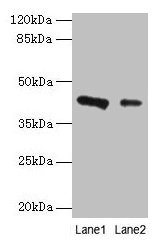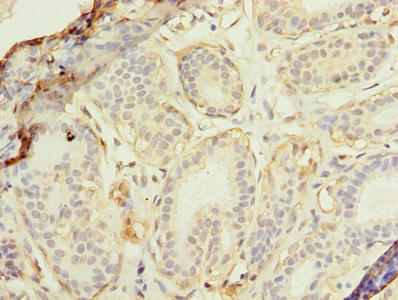-
货号:CSB-PA019260LA01HU
-
规格:¥440
-
促销:
-
图片:
-
Western blot
All lanes: RAD23B antibody at 2µg/ml
Lane 1: 293T whole cell lysate
Lane 2: MCF-7 whole cell lysate
Secondary
Goat polyclonal to rabbit IgG at 1/10000 dilution
Predicted band size: 44, 36 kDa
Observed band size: 44 kDa -
Immunohistochemistry of paraffin-embedded human breast cancer using CSB-PA019260LA01HU at dilution of 1:100
-
-
其他:
产品详情
-
产品名称:Rabbit anti-Homo sapiens (Human) RAD23B Polyclonal antibody
-
Uniprot No.:P54727
-
基因名:
-
别名:hHR 23b antibody; hHR23B antibody; HR 23B antibody; HR23B antibody; mHR 23B antibody; mHR23B antibody; p58 antibody; RAD 23B antibody; RAD23 (S. cerevisiae) homolog B antibody; RAD23 homolog B (S. cerevisiae) antibody; RAD23 homolog B antibody; RAD23 yeast homolog of B antibody; Rad23b antibody; RD23B_HUMAN antibody; UV excision repair protein RAD23 homolog B antibody; XP C repair complementing complex 58 kDa antibody; XP C repair complementing complex 58 kDa protein antibody; XP C repair complementing protein antibody; XP-C repair-complementing complex 58 kDa protein antibody; XPC repair complementing complex 58 kDa antibody; XPC repair complementing complex 58 kDa protein antibody; XPC repair complementing protein antibody
-
宿主:Rabbit
-
反应种属:Human
-
免疫原:Recombinant Human UV excision repair protein RAD23 homolog B protein (1-250AA)
-
免疫原种属:Homo sapiens (Human)
-
标记方式:Non-conjugated
本页面中的产品,RAD23B Antibody (CSB-PA019260LA01HU),的标记方式是Non-conjugated。对于RAD23B Antibody,我们还提供其他标记。见下表:
-
克隆类型:Polyclonal
-
抗体亚型:IgG
-
纯化方式:>95%, Protein G purified
-
浓度:It differs from different batches. Please contact us to confirm it.
-
保存缓冲液:Preservative: 0.03% Proclin 300
Constituents: 50% Glycerol, 0.01M PBS, PH 7.4 -
产品提供形式:Liquid
-
应用范围:ELISA, WB, IHC
-
推荐稀释比:
Application Recommended Dilution WB 1:500-1:5000 IHC 1:20-1:200 -
Protocols:
-
储存条件:Upon receipt, store at -20°C or -80°C. Avoid repeated freeze.
-
货期:Basically, we can dispatch the products out in 1-3 working days after receiving your orders. Delivery time maybe differs from different purchasing way or location, please kindly consult your local distributors for specific delivery time.
引用文献
- Molecular and Kinetic Analyses of Circulating Tumor Cells as Predictive Markers of Treatment Response in Locally Advanced Rectal Cancer Patients Troncarelli Flores BC, et al,Cells,2019
相关产品
靶点详情
-
功能:Multiubiquitin chain receptor involved in modulation of proteasomal degradation. Binds to polyubiquitin chains. Proposed to be capable to bind simultaneously to the 26S proteasome and to polyubiquitinated substrates and to deliver ubiquitinated proteins to the proteasome. May play a role in endoplasmic reticulum-associated degradation (ERAD) of misfolded glycoproteins by association with PNGase and delivering deglycosylated proteins to the proteasome.; Involved in global genome nucleotide excision repair (GG-NER) by acting as component of the XPC complex. Cooperatively with CETN2 appears to stabilize XPC. May protect XPC from proteasomal degradation.; The XPC complex is proposed to represent the first factor bound at the sites of DNA damage and together with other core recognition factors, XPA, RPA and the TFIIH complex, is part of the pre-incision (or initial recognition) complex. The XPC complex recognizes a wide spectrum of damaged DNA characterized by distortions of the DNA helix such as single-stranded loops, mismatched bubbles or single-stranded overhangs. The orientation of XPC complex binding appears to be crucial for inducing a productive NER. XPC complex is proposed to recognize and to interact with unpaired bases on the undamaged DNA strand which is followed by recruitment of the TFIIH complex and subsequent scanning for lesions in the opposite strand in a 5'-to-3' direction by the NER machinery. Cyclobutane pyrimidine dimers (CPDs) which are formed upon UV-induced DNA damage esacpe detection by the XPC complex due to a low degree of structural perurbation. Instead they are detected by the UV-DDB complex which in turn recruits and cooperates with the XPC complex in the respective DNA repair. In vitro, the XPC:RAD23B dimer is sufficient to initiate NER; it preferentially binds to cisplatin and UV-damaged double-stranded DNA and also binds to a variety of chemically and structurally diverse DNA adducts. XPC:RAD23B contacts DNA both 5' and 3' of a cisplatin lesion with a preference for the 5' side. XPC:RAD23B induces a bend in DNA upon binding. XPC:RAD23B stimulates the activity of DNA glycosylases TDG and SMUG1.
-
基因功能参考文献:
- miR-196b improved radiosensitivity of SNU-638 cells by targeting RAD23B. PMID: 29864624
- Several mutations in the two parts of the central "crest" of the arrestin molecule, middle-loop and C-loop, enhanced or reduced arrestin-3 interactions with several GPCRs in receptor subtype and functional state-specific manner. PMID: 28473198
- XPC dissociation from the damage site could become a rate-limiting step in nucleotide excision repair (NER) of certain types of DNA adducts, leading to repression of NER. PMID: 27327897
- HR23B role in DNA reapair, in protein degradation and stability, tumorigenesis and neurodegenerative disorders [review] PMID: 27771451
- Data show that nucleotide excision repair factor XPC-RAD23B is a target of poly(ADP-ribosyl)ation catalyzed by poly(ADP-ribose) polymerase 1 (PARP1). PMID: 26170451
- RAD23B has a potential role in breast cancer progression and a tumor suppressor role of nuclear RAD23B in breast cancer. PMID: 24897598
- It is unlikely that the RAD23B 249Val/Val polymorphism may contribute to the individual susceptibility to cancer risk. PMID: 24643114
- Results define a regulatory mechanism that involves the interplay between HR23B and HDAC6 that influences the biological outcome of HDAC inhibitor treatment. PMID: 23703321
- Polymorphism in RAD23B gene is associated with breast cancer. PMID: 23776089
- HR23B expression was associated with disease stabilization for patients with unresectable hepatocellular carcinoma treated with epigenetic therapy using belinostat, a histone deacetylase inhibitor. PMID: 22915658
- Single nucleotide polymorphisms of CCND2, RAD23B, GRP78, CEP164, MDM2, and ALDH2 genes were significantly associated with development and recurrence of hepatocellular carcinoma in Japanese patients with hepatitis C virus. PMID: 22004425
- PNGase-PUB serves not only as p97-binding module but also as a possible activator of HR23 in endoplasmic reticulum-associated degradation mechanisms. PMID: 22575648
- 26S proteasomes and p97/VCP complexes bind to the ubiquitin-like domain of HHR23B. PMID: 19182904
- Gene expression of RAD23B was down-regulated during early apoptosis in human hepatoma cells exposed to Paeoniae Radix extract in vitro. PMID: 12215374
- analysis of mHR23A/B double-mutant cells showed that HR23 proteins function in nucleotide excision repair by governing xeroderma pigmentosum group C protein stability via partial protection against proteasomal degradation PMID: 12815074
- Highly expressed in the human testis and in ejaculated spermatozoa. This novel alternative splicing form of RAD23B is correlated with human spermatogenesis. PMID: 15064313
- the human nucleotide excision repair gene, hHR23B, is epigenetically silenced in interleukin-6-responsive multiple myeloma KAS-6/1 cells PMID: 15550378
- Results describe the solution structure of a protein fragment containing amino acids 275-342 of hHR23B and compare it with the previously reported solution structures of the corresponding domain of hHR23A. PMID: 15885096
- intracellular distribution hHR23B is cell cycle dependent PMID: 16253613
- determined that hHR23A and hHR23B could be co-purified with unique proteolytic and stress-responsive factors from human breast cancer tissues, indicating that they have unique functions in vivo PMID: 16712842
- Fluorescence correlation spectroscopy of the binding of nucleotide excision repair protein XPC-HHR23B with DNA substrates is reported. PMID: 18574675
- Genetic polymorphisms in RAD23B is associated with Laryngeal cancer risk associated with smoking and alcohol consumption. PMID: 19444904
- XPC subunit interaction with DNA is stimulated by endogenous HR23B. PMID: 19538122
- BRG1 stimulates the recruitment of XPG and PCNA to successfully culminate the nucleotide excision repair. PMID: 19740755
显示更多
收起更多
-
亚细胞定位:Nucleus. Cytoplasm. Note=The intracellular distribution is cell cycle dependent. Localized to the nucleus and the cytoplasm during G1 phase. Nuclear levels decrease during S-phase; upon entering mitosis, relocalizes in the cytoplasm without association with chromatin.
-
蛋白家族:RAD23 family
-
数据库链接:
HGNC: 9813
OMIM: 600062
KEGG: hsa:5887
STRING: 9606.ENSP00000350708
UniGene: Hs.521640
Most popular with customers
-
-
YWHAB Recombinant Monoclonal Antibody
Applications: ELISA, WB, IF, FC
Species Reactivity: Human, Mouse, Rat
-
Phospho-YAP1 (S127) Recombinant Monoclonal Antibody
Applications: ELISA, WB, IHC
Species Reactivity: Human
-
-
-
-
-























